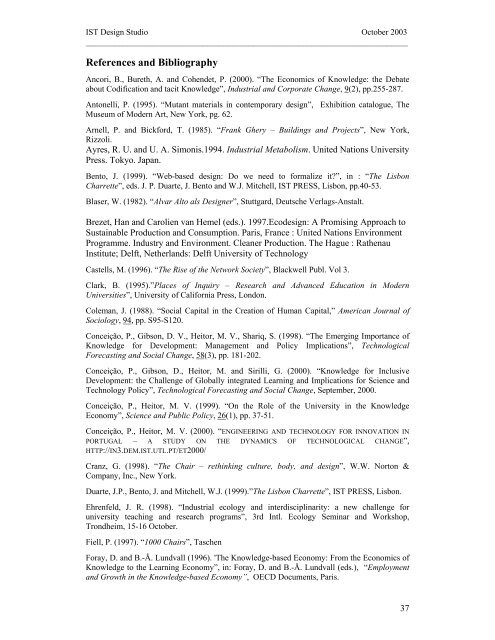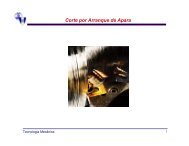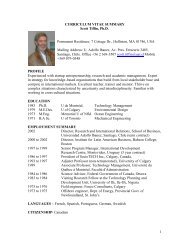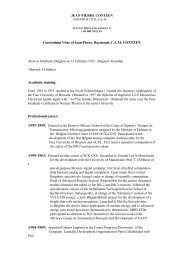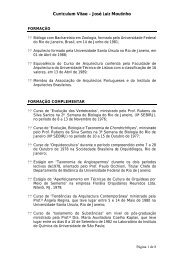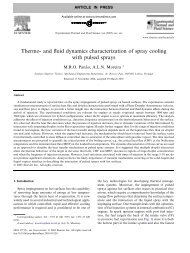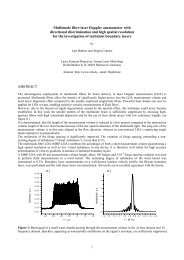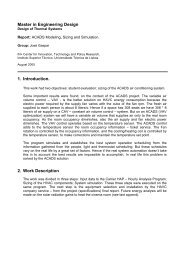THE IST DESIGN STUDIO: a plan for action⦠by Manuel ... - In+
THE IST DESIGN STUDIO: a plan for action⦠by Manuel ... - In+
THE IST DESIGN STUDIO: a plan for action⦠by Manuel ... - In+
You also want an ePaper? Increase the reach of your titles
YUMPU automatically turns print PDFs into web optimized ePapers that Google loves.
<strong>IST</strong> Design Studio October 2003_____________________________________________________________________________References and BibliographyAncori, B., Bureth, A. and Cohendet, P. (2000). “The Economics of Knowledge: the Debateabout Codification and tacit Knowledge”, Industrial and Corporate Change, 9(2), pp.255-287.Antonelli, P. (1995). “Mutant materials in contemporary design”, Exhibition catalogue, TheMuseum of Modern Art, New York, pg. 62.Arnell, P. and Bick<strong>for</strong>d, T. (1985). “Frank Ghery – Buildings and Projects”, New York,Rizzoli.Ayres, R. U. and U. A. Simonis.1994. Industrial Metabolism. United Nations UniversityPress. Tokyo. Japan.Bento, J. (1999). “Web-based design: Do we need to <strong>for</strong>malize it?”, in : “The LisbonCharrette”, eds. J. P. Duarte, J. Bento and W.J. Mitchell, <strong>IST</strong> PRESS, Lisbon, pp.40-53.Blaser, W. (1982). “Alvar Alto als Designer”, Stuttgard, Deutsche Verlags-Anstalt.Brezet, Han and Carolien van Hemel (eds.). 1997.Ecodesign: A Promising Approach toSustainable Production and Consumption. Paris, France : United Nations EnvironmentProgramme. Industry and Environment. Cleaner Production. The Hague : RathenauInstitute; Delft, Netherlands: Delft University of TechnologyCastells, M. (1996). “The Rise of the Network Society”, Blackwell Publ. Vol 3.Clark, B. (1995).”Places of Inquiry – Research and Advanced Education in ModernUniversities”, University of Cali<strong>for</strong>nia Press, London.Coleman, J. (1988). “Social Capital in the Creation of Human Capital,” American Journal ofSociology, 94, pp. S95-S120.Conceição, P., Gibson, D. V., Heitor, M. V., Shariq, S. (1998). “The Emerging Importance ofKnowledge <strong>for</strong> Development: Management and Policy Implications”, TechnologicalForecasting and Social Change, 58(3), pp. 181-202.Conceição, P., Gibson, D., Heitor, M. and Sirilli, G. (2000). “Knowledge <strong>for</strong> InclusiveDevelopment: the Challenge of Globally integrated Learning and Implications <strong>for</strong> Science andTechnology Policy”, Technological Forecasting and Social Change, September, 2000.Conceição, P., Heitor, M. V. (1999). “On the Role of the University in the KnowledgeEconomy”, Science and Public Policy, 26(1), pp. 37-51.Conceição, P., Heitor, M. V. (2000). “ENGINEERING AND TECHNOLOGY FOR INNOVATION INPORTUGAL – A STUDY ON <strong>THE</strong> DYNAMICS OF TECHNOLOGICAL CHANGE”,HTTP://IN3.DEM.<strong>IST</strong>.UTL.PT/ET2000/Cranz, G. (1998). “The Chair – rethinking culture, body, and design”, W.W. Norton &Company, Inc., New York.Duarte, J.P., Bento, J. and Mitchell, W.J. (1999).”The Lisbon Charrette”, <strong>IST</strong> PRESS, Lisbon.Ehrenfeld, J. R. (1998). “Industrial ecology and interdisciplinarity: a new challenge <strong>for</strong>university teaching and research programs”, 3rd Intl. Ecology Seminar and Workshop,Trondheim, 15-16 October.Fiell, P. (1997). “1000 Chairs”, TaschenForay, D. and B.-Å. Lundvall (1996). 'The Knowledge-based Economy: From the Economics ofKnowledge to the Learning Economy”, in: Foray, D. and B.-Å. Lundvall (eds.), “Employmentand Growth in the Knowledge-based Economy”, OECD Documents, Paris.37


